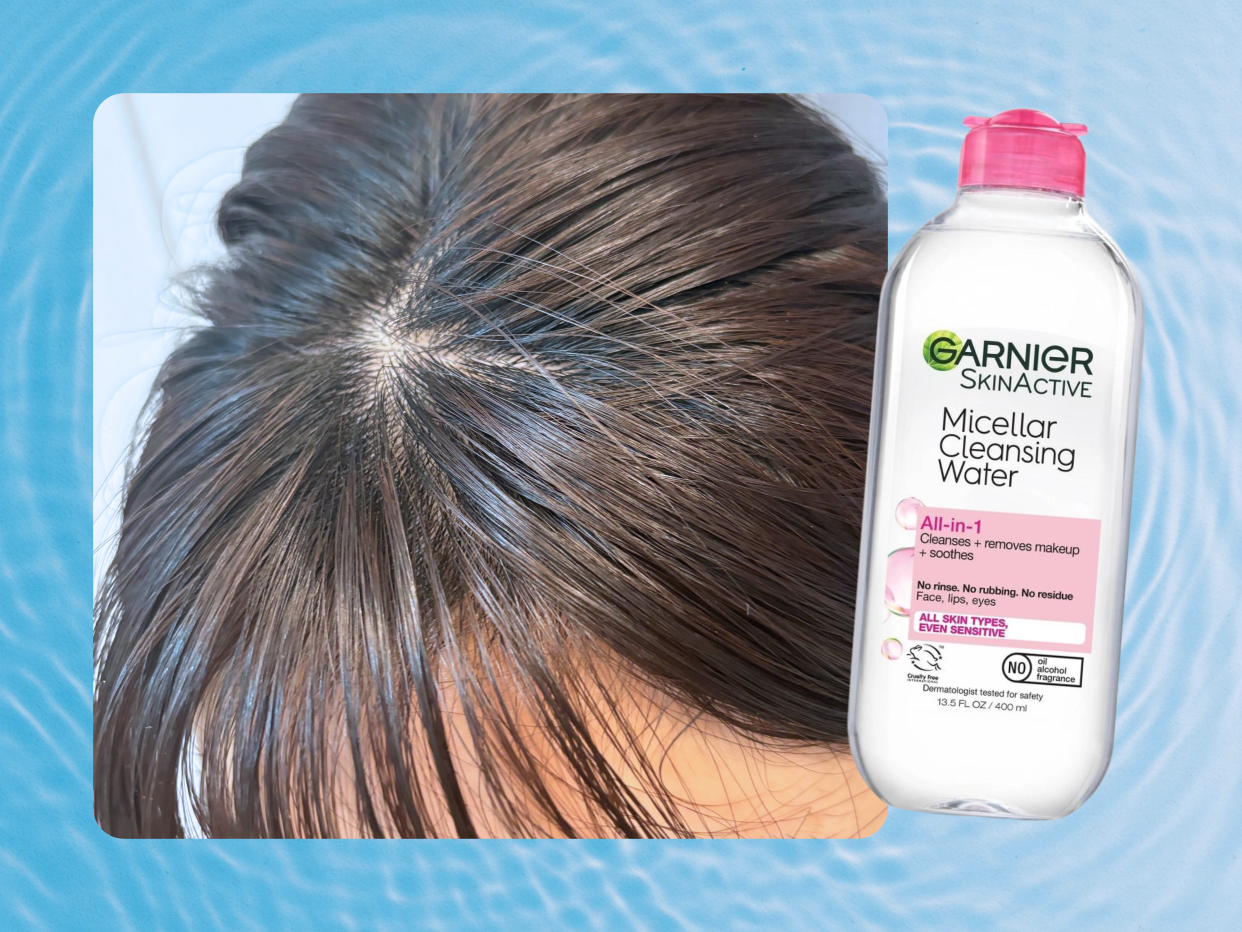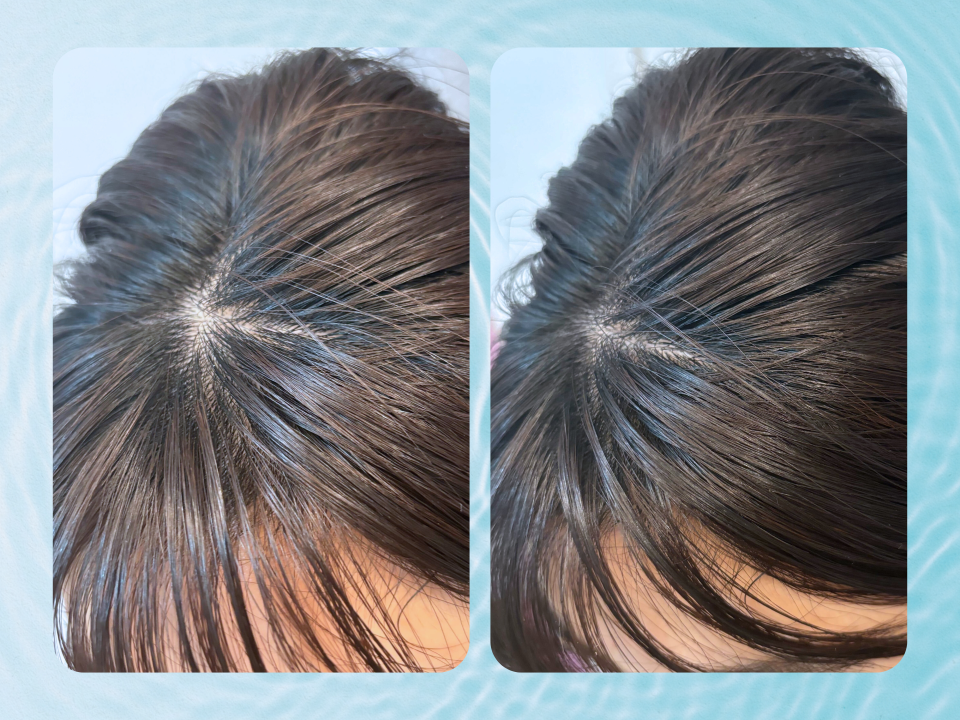I Tried the TikTok Micellar Water Hack to Refresh My Oily Hair—Here’s How It Went (With Photos)

Jenna Ryu/Garnier
I have a bone to pick with the humid, sweltering weather in NYC right now. I’m already cursed with naturally oily hair, so a few hours outside in the summer heat is all it takes to undo my freshly washed roots and leave them greasy and gross.
I know dry shampoo is supposed to be a lifesaver for those moments when you need—but can’t squeeze in—a full shower. But I’ve also learned that these oil-sopping sprays and powders can be disappointing: They usually leave a noticeably white residue on my pitch-black hair, and even the products designed to blend into darker strands tend to create a rough, stiff texture that I hate.
So when I saw tons of people on TikTok raving about how micellar water—a facial cleansing staple that I already have on hand—can also soak up oil on your scalp without the dreaded firmness or chalky hue, I had to know more. Here’s how the so-called genius solution allegedly works: First, you apply an (oil-free) micellar water (either with a cotton pad or by using a spray bottle) directly onto your roots. Then, you quickly blow-dry the area for instantly refreshed, voluminous, non-powdery results.
In theory, this trick makes sense, Azadeh Shirazi, MD, a San Diego–based dermatologist at La Jolla Dermatology, tells SELF. Micellar water is made of molecules that “have a hydrophilic (water-attracting) head and hydrophobic (oil-loving) tail,” Dr. Shirazi explains. “And the hydrophobic side will bind to and grab onto oil, dirt, and other buildup”—which is why micellar water is so great at removing sunscreen and makeup from your face. So the idea is that this convenient skin care savior should work similarly to clean your hair.
This sounds promising but, again, it’s just a theory: There isn’t any research to back up micellar water as a legit solution for oily scalps, in particular. So given the lack of solid science, I figured the only way to find out if this trend lives up to the hype was to test it myself.
So did TikTok’s micellar water hack make my hair less oily?
The best way to try it out for yourself, according to Dr. Shirazi, is with a cotton pad soaked in micellar water instead of the spray bottle method. (This move, she says, will prevent you from using too much product and oversaturating your hair.)
So, that’s exactly what I did with my Garnier SkinActive Micellar Cleansing Water on day-three hair (after a sweaty boxing class): I dabbed the liquid all over my roots, finger-combed them to ensure the micellar water was evenly distributed, then waited a few minutes (to let it do its oil-grabbing thing). Finally, I fired up my Dyson and blasted my scalp with hot air for 30 seconds.
My immediate reaction: disappointment. To start with the plus side, my hair did feel smoother and cleaner than before. That said, it was still kind of…sticky. (Dry shampoos may not be my favorite, but the ones I’ve tried definitely did a better job at removing buildup). Another issue? My hair still looked shiny (or as my partner kindly put it, “a little greasy”), defeating the purpose of tricking people into thinking I recently showered. Plus my roots appeared flat and lacked the oomph I was hoping for. (So, as someone who was promised voluminous, perked-up results on TikTok, I was let down.)

At first, I assumed I must have done something wrong—or perhaps my scalp was just that oily—because a lot of TikTokers touted salon-worthy before-and-afters. But, according to Dr. Shirazi, my experience isn’t that surprising: Micellar water is still technically a cleanser—meaning that it’s supposed to be rinsed (or at least wiped) off in order to avoid a sticky or heavy residue, she says.
Also, this holy grail makeup remover is meant for—and has been studied on—bare (relatively hairless) faces, so it’s unclear if its oil-absorbing magic would even work on an area like the scalp. In fact, Dr. Shirazi theorizes that the micelles may actually cling to and saturate your hair shafts, possibly causing your strands to feel weighed down. (Again, there’s no research on micellar water for dirty hair specifically, but this theory could explain why my roots ended up looking shiny and flat.)
The bottom line? Even though my roots felt a bit cleaner, this trend didn’t hide signs of my sweaty workout well enough to replace dry shampoo. If anything, I’m taking this experience as a reminder to not blindly fall for every viral hack that shows up on my feed.
That said, if you’re curious to try it out for yourself, by all means, go for it. Micellar water is generally safe for skin and unlikely to cause irritation, Dr. Shirazi says. Plus everyone’s hair is different, so what doesn’t work for me may be a game changer for you (that certainly seems to be the case for all the TikTokers who swear by it). Based on my underwhelming results, though, I think I’ll stick to saving my beloved Garnier bottle for my face, not my hair.
Related:
Originally Appeared on SELF


